Your lawn’s health depends on spotting disease early. Most homeowners lose their grass to preventable fungal infections that start small but spread quickly. This guide covers the seven most common lawn diseases, their warning signs, and proven treatment methods that actually work.
What Causes Lawn Diseases?
Lawn diseases develop when three conditions meet: a disease-causing organism (usually fungus), a susceptible grass type, and the right environmental conditions. Poor drainage, overwatering, and humid weather create perfect breeding grounds for fungal infections.
Weather plays the biggest role. Cool, wet springs favor snow mold and dollar spot. Hot, humid summers trigger brown patch and summer patch. Fall brings leaf spot diseases as temperatures drop.
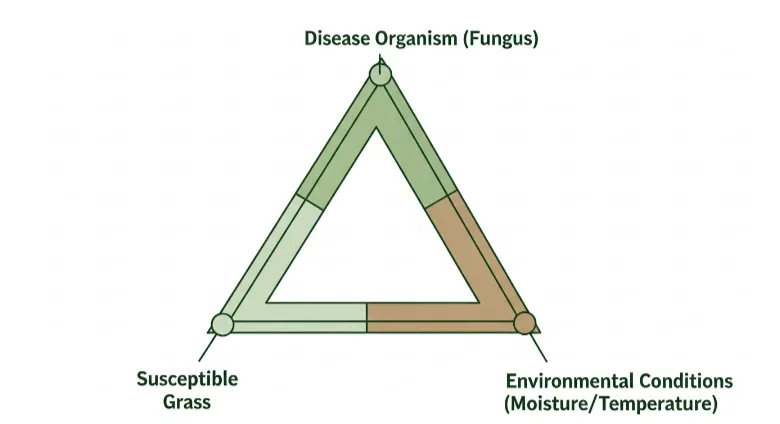
Brown Patch Disease
Brown patch creates circular patches of dead grass ranging from 6 inches to several feet wide. The grass blades turn brown from the tip down, and you’ll often see a dark ring around the patch’s edge.
Signs of Brown Patch:
- Circular brown patches in lawn
- Grass blades with tan lesions
- Dark smoke ring around patch edges
- Worse in hot, humid weather (80-95°F)
- Most active during summer nights
How to Fix Brown Patch:
Apply a fungicide containing propiconazole or azoxystrobin as soon as you spot symptoms. Water early morning only, never at night. Improve air circulation by pruning nearby shrubs and trees.
Reduce nitrogen fertilizer during hot weather. Brown patch feeds on excess nitrogen. Switch to slow-release fertilizers in spring and fall instead of summer applications.
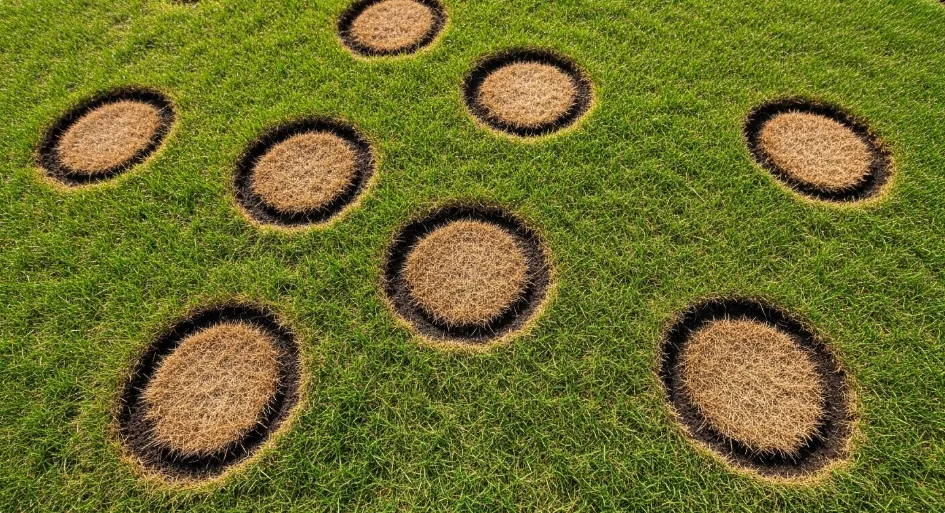
Dollar Spot Disease
Dollar spot creates small, silver-dollar-sized brown patches throughout your lawn. Individual grass blades develop tan lesions with reddish-brown borders. Look for white, cobweb-like threads on grass in early morning.
This disease thrives in cool, wet conditions with poor soil nutrition. Lawns low in nitrogen are most susceptible.
Treatment for Dollar Spot:
- Apply nitrogen fertilizer to strengthen grass
- Use fungicides with thiophanate-methyl or propiconazole
- Water deeply but less frequently
- Collect and dispose of grass clippings
- Improve soil drainage with core aeration
Fairy Ring
Fairy rings appear as dark green circles of thick grass, often with mushrooms growing along the ring’s edge. Some rings have dead grass in the center or along the ring itself.
Three types exist: Type 1 kills grass, Type 2 stimulates growth without killing, and Type 3 produces mushrooms without affecting grass color.
Fairy Ring Solutions:
Breaking up fairy rings requires patience. Apply high-nitrogen fertilizer to mask symptoms. Remove mushrooms immediately to prevent spore spread.
Core aerate the affected area multiple times. Apply a wetting agent to improve water penetration. In severe cases, remove soil 12 inches deep and reseed.
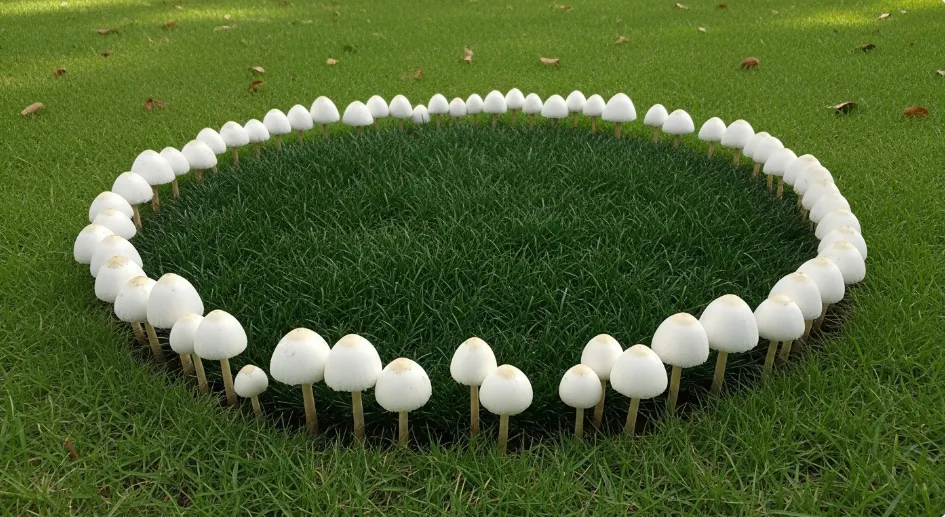
Snow Mold (Gray and Pink)
Snow mold develops under snow cover during winter. Gray snow mold creates circular patches of matted, grayish grass. Pink snow mold appears more orange or pink and damages grass more severely.
Both types become visible when snow melts in spring. Affected areas look water-soaked and matted down.
Snow Mold Prevention and Treatment:
- Rake affected areas gently in spring
- Apply balanced fertilizer once grass starts growing
- Avoid late fall nitrogen applications
- Keep grass short before first snowfall
- Improve drainage in problem areas
Most cases recover naturally with spring growth and proper care.
Leaf Spot and Melting Out
Leaf spot starts as small, dark spots on grass blades. These spots have tan centers with dark brown or purple borders. As the disease progresses, it attacks grass crowns and roots, causing “melting out.”
Cool, wet weather in spring and fall favors this disease. Stressed grass from poor nutrition or compacted soil suffers most.
Treating Leaf Spot:
- Reduce watering frequency but increase depth
- Apply preventive fungicides in early spring
- Fertilize appropriately for your grass type
- Core aerate compacted lawns
- Overseed thin areas with resistant grass varieties
Red Thread Disease
Red thread creates irregular patches of tan or bleached grass. Look for red or pink thread-like growths extending from grass blade tips. The disease rarely kills grass but makes lawns look unsightly.
This fungal disease prefers cool, moist conditions and attacks underfertilized lawns most often.
Red Thread Treatment:
Apply nitrogen fertilizer to boost grass health. Most cases resolve with proper nutrition alone. For severe infections, use fungicides containing chlorothalonil or propiconazole.
Improve air circulation and reduce shade where possible. Overseed with resistant grass varieties if problems persist.
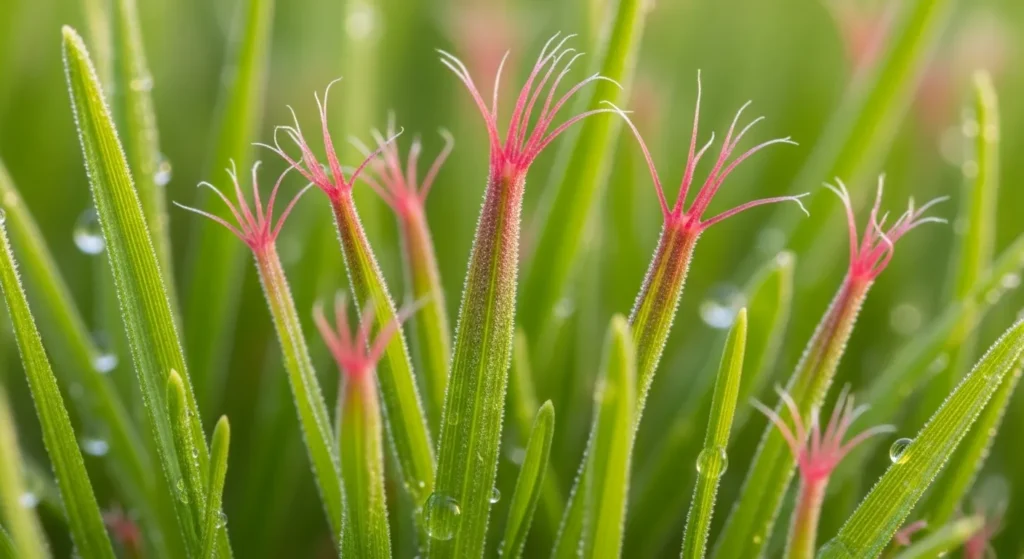
Summer Patch Disease
Summer patch creates circular patches of dead grass during hot summer weather. The center often recovers, creating a “frog-eye” pattern. Grass roots turn black, and the disease spreads slowly outward.
This soil-borne fungus attacks grass roots in hot, humid conditions. Compacted, poorly drained soils make the problem worse.
Summer Patch Management:
- Deep, infrequent watering only
- Core aerate compacted areas
- Apply preventive fungicides in late spring
- Avoid excess nitrogen during summer
- Overseed with resistant grass varieties
Recovery takes time since roots are damaged. Focus on preventing new infections.
Preventing Lawn Diseases
Prevention beats treatment every time. Healthy grass resists disease naturally. Follow these practices to keep your lawn disease-free:
Proper Watering Techniques
Water early morning between 4-8 AM. This gives grass time to dry before evening when fungi become active. Apply 1-1.5 inches per week through deep, infrequent sessions.
Avoid evening watering at all costs. Wet grass overnight creates perfect conditions for fungal growth.
Fertilization Best Practices
Feed your grass according to soil test results. Over-fertilized lawns attract more diseases than underfed ones. Use slow-release fertilizers for steady nutrition without growth spurts.
Time applications correctly. Heavy nitrogen in summer heat stresses grass and invites brown patch disease.
Improve Air Circulation
Trim shrubs and tree branches that block airflow over your lawn. Good air movement helps grass dry quickly after rain or irrigation.
Remove thatch buildup over 0.5 inches thick. Thick thatch holds moisture and creates disease-friendly conditions.
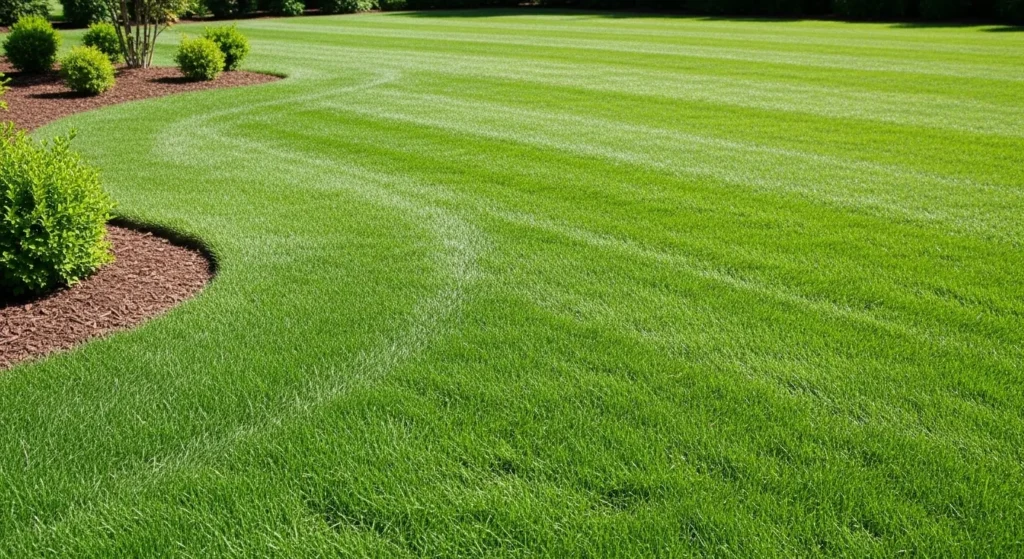
When to Call Professionals
Contact lawn care professionals when diseases cover more than 30% of your lawn or keep returning despite treatment efforts. Professional diagnosis prevents wasting money on wrong treatments.
Some fungal diseases require prescription fungicides not available to homeowners. Professionals also have access to commercial-grade equipment for proper application coverage.
Seasonal Disease Calendar
Different diseases appear at specific times:
Spring (March-May): Snow mold, leaf spot, fairy ring Summer (June-August): Brown patch, dollar spot, summer patch
Fall (September-November): Leaf spot, red thread, fairy ring
Plan prevention treatments before disease seasons begin. Spring fungicide applications prevent summer diseases more effectively than treating active infections.
Choosing Disease-Resistant Grass
Some grass varieties resist diseases better than others. When overseeding or replanting, choose resistant cultivars for your area.
Cool-season grasses: Look for tall fescue blends with endophytes or disease-resistant perennial ryegrass varieties.
Warm-season grasses: Choose Zoysia or Bermuda grass varieties bred for fungal resistance.
Your local extension office maintains lists of recommended grass varieties for your specific region and climate conditions.
Natural Disease Management
Organic approaches work well for minor disease problems. Baking soda solutions (1 tablespoon per gallon) can slow fungal growth on contact.
Compost tea applications boost beneficial microorganisms that compete with disease-causing fungi. Apply monthly during growing season for best results.
Corn meal contains beneficial bacteria that suppress some soil-borne fungal diseases. Spread 20 pounds per 1,000 square feet in early spring.
Recovery After Disease Treatment
Damaged areas need time to recover after successful disease treatment. Overseed thin spots in fall for cool-season grasses or late spring for warm-season varieties.
Keep recovering areas moist but not soggy. Light, frequent watering helps new seedlings establish without creating conditions for disease return.
Apply starter fertilizer to new seeded areas. Established grass benefits from balanced fertilizer applications according to soil test recommendations.
Maintenance Schedule for Disease Prevention
Monthly Tasks:
- Inspect lawn for early disease signs
- Adjust watering based on weather
- Remove fallen leaves and debris
- Check and clean irrigation systems
Seasonal Tasks:
- Spring: Apply pre-emergent fungicides, fertilize, overseed thin areas
- Summer: Monitor watering, reduce foot traffic during stress
- Fall: Core aerate, apply winter fertilizer, final mowing
- Winter: Plan next year’s lawn care program
Annual Tasks:
- Soil testing for pH and nutrient levels
- Evaluate grass variety performance
- Review and update disease prevention strategies
- Professional lawn assessment if problems persist
Regular maintenance prevents most disease problems before they start. Consistent care costs less than treating severe infections and replacing dead grass areas.
